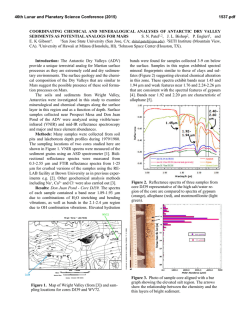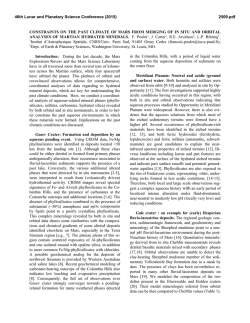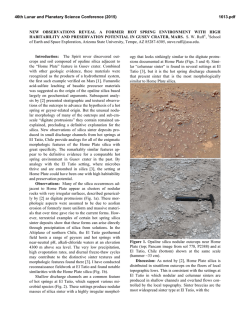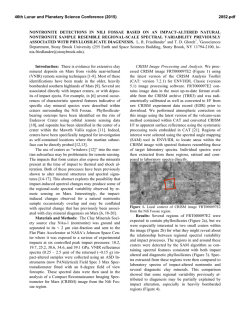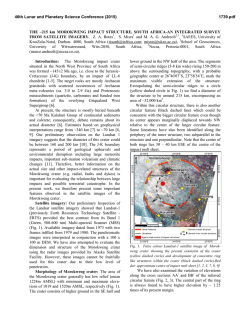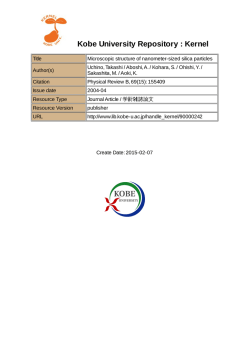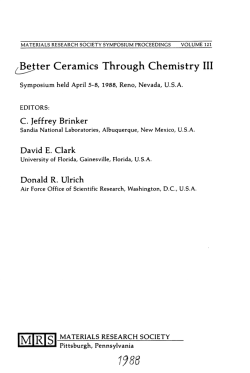
hydrated silica as a mineralogic marker for hesperian mars
46th Lunar and Planetary Science Conference (2015) 2157.pdf HYDRATED SILICA AS A MINERALOGIC MARKER FOR HESPERIAN MARS: CONSTRAINING ENVIRONMENTAL CONDITIONS FROM ORBITAL AND LABORATORY DATA. V. Z. Sun1, R. E. Milliken1, S. W. Ruff2, and J. D. Farmer2 1Dept. of Earth, Environmental, and Planetary Sciences, Brown Univ., RI 02912 ([email protected]), 2School of Earth and Space Exploration, Arizona State Univ., AZ 85287. Introduction: The history of aqueous alteration on Mars is largely derived from the association of specific hydrated minerals with geologic periods. The Noachian has been characterized as a warm, wet, and habitable environment from extensive studies of Noachian-age clay mineral deposits [1,2]. In contrast, inferred drier, sulfate-forming environments in the Hesperian period are less understood, particularly in regard to their acidity and potential for habitability [1,3,4]. Hydrated silica deposits can aid in resolving this issue as they are now recognized as a significant component of alteration products on Mars [2,5,6], with most detections dated to the Hesperian [5,7]. However, many of these Hesperian-age hydrated silica deposits occur in two different settings: 1) in association with Fe-sulfates in and around Valles Marineris, indicating acidic conditions [5,8], and 2) in the presence of clay minerals within crater environments, suggesting more alkaline conditions [7]. Understanding these occurences requires not only orbital study of hydrated silica in its mineralogic and geologic context, but also spectral characterization of hydrated silica in the laboratory to relate spectral variations to degree of maturation and possible formation conditions. In this work we characterize hydrated silica spectra under simulated martian atmospheric conditions to relate their hydration (H2O and OH) absorptions to formation environments. The derived spectral parameters are then applied to CRISM visible-near infrared spectra of hydrated silica on Mars. The results will allow us to interpret orbital hydrated silica detections and better resolve the Hesperian environment in regard to its potential for habitability. Lab Methods: Silica-rich samples from Hawaii, New Zealand, and Yellowstone, representing acidic fumarole (or a proxy for martian acid-sulfate leaching) and alkaline hot spring environments, are analyzed in the lab. Hydrated silica spectra are defined by hydration absorptions at 1.4, 1.9, and 2.2 µm (Figure 1), which vary depending on how H2O is held in the structure and the crystallinity (opal-A versus opal-CT) and thus may reflect differences in formation environments [9-11]. These samples are first measured under ambient conditions in chip and powder (<45 µm) forms, using reflectance measurements from 0.4-2.5 µm measured with an ASD spectrometer and from 1.5-2.6 µm using an FTIR spectrometer at the RELAB facility at Brown Univ. The ASD measurements are then repeated in an environmental chamber under Mars-relevant pressure (6 mbar), temperature (-50 °C), and relative humidity (0.001 mbar H2O). This step is necessary as spectral features associated with Si-OH can vary with pressure and temperature [12], and distinguishing these effects Figure 1. Hydrated silica spectra from Elorza crater and Melas Chasma on Mars (CRISM) compared against laboratory spectra (ambient conditions) of Yellowstone and Hawaii samples. will help apply the lab results to the orbital data. Powder XRD data are used to characterize sample mineralogy (e.g., distinguish opal-A and opal-CT), assess how mineral assemblages vary between different environments, and to link mineralogy to spectra. The 1.4, 1.9, and 2.2 µm absorptions of each sample are then modeled with Gaussian curves centered at 1.4, 1.46, 1.9, 1.96, 2.21, and 2.26 µm, which are attributed to different bonding environments of OH and H2O within the hydrated silica structure [10]. The band depths of the individual absorptions are determined from the Gaussian fits and band depth ratios are used to characterize absorption shapes and relative strengths. CRISM Analysis: The lab-derived spectral parameters will be applied to CRISM hydrated silica spectra from the two Hesperian settings: Valles Marineris [5,8] and crater environments [7]. In both settings, CRISM spectral data will be used to determine the presence of hydrated silica and accompanying mineral assemblages, which can help discern the type of formation environment (e.g., acidic from the presence of jarosite/alunite, alkaline from the presence of clays and absence of acidic sulfates). Detections will be correlated to geomorphology and stratigraphy in HiRISE images to determine the geologic context and origin of the hydrated silicabearing units. In the case of crater settings, the formation age of the hydrated silica can be constrained by the crater count age of the host crater [7]. In Valles Marineris, hydrated silica-bearing strata have been stratigraphically constrained to the Hesperian [5], but 46th Lunar and Planetary Science Conference (2015) this work will attempt to derive a more quantitative age from crater counts on exposed strata. Obtaining formation ages of hydrated silica in these two settings will help determine if their mineralogic differences are due to different ages (implying different global conditions through time) or different (but contemporary) formation conditions. Finally, CRISM spectra will be assessed with the same Gaussian modeling that was applied to the laboratory spectra. CRISM spectra will be plotted using the same band depth parameters for direct comparison to the lab spectra of silica samples from different terrestrial environments (fumarole vs. hot spring). This comparison will allow us to evaluate if martian silica deposits represent distinct formation conditions. Lab Results: Preliminary reflectance spectra acquired under ambient conditions show spectral variations that may be attributed to different formation environments (Figure 2). Both hot spring (Yellowstone) and fumarole (Hawaii) samples encompass a similar range of values in terms of the 2.21/2.26 µm band depth ratio. However, they appear distinguishable by their 1.4/1.46 and 1.9/1.96 µm band depth ratios, as the Yellowstone samples consistently have higher values than the Hawaii samples. The high 1.4/1.46 and 1.9/1.96 µm ratios reflects less H2O, possibly indicating differences between opal-A and opal-C/CT. Figure 2. Laboratory (orange = Yellowstone, purple = Hawaii) and CRISM crater (open circles) spectral data plotted in band depth space. Orbital Results: CRISM analysis of both Valles Marineris and crater environments reveal great diversity in the spectra of hydrated silica on Mars (Figure 1). Most examples appear strongly hydrated, with a strong 1.9 µm absorption (indicating H2O) and Si-OH absorptions centered at slightly longer wavelengths (e.g., 1.41 µm), although there are also some instances of H2O-poor silica (absent 1.9 µm feature and Si-OH absorptions at ~1.38 µm) [5]. This diversity is particularly apparent in the 40 km Elorza crater, which hosts hydrated and dehydrated silica only several kilometers apart (Figure 3). We also confirm that hydrated silica in Valles Marineris is associated with jarosite, suggesting acidic formation conditions, whereas hydrated silica in crater environments occurs with clays rather than sulfates, possibly indicating more alkaline conditions. However, application of Gaussian modeling to the CRISM spectra shows that most 2157.pdf occurrences of crater hydrated silica are consistent with the Hawaii samples in band depth space (Figure 2). This may indicate that these martian hydrated silica may have formed under acidic conditions, although there are a few occurrences that plot closer to the alkaline Yellowstone samples. Figure 3. Central pit of Elorza crater (8.76°N, 304.8°E), showing the close proximity of hydrated (blue) and dehydrated (red) silica (Fig. 1). 4 km We find that hydrated silica in crater environments occur from 3.9-3.4 Ga, with a distribution peaking at 3.4 Ga [7]. The majority of these detections are not in excavated (uplifted) units, raising the possibility that their occurrence may be linked to impact melt or other impact-induced aqueous alteration process. Ongoing work includes more quantitative age estimates of the Hesperian deposits near Valles Marineris [5]. These hydrated silica-bearing deposits are in close proximity to inverted channels, suggesting a sedimentary origin. Discussion: Current results suggest that the Hesperian environment was much more complex with respect to aqueous processes than typically recognized. Hydrated silica appears to be a mineralogic marker of this time period, yet it seems to have formed in two distinct settings under very different conditions. These hydrated silica deposits may result from distinct formation environments, such as impact-induced aqueous alteration or precipitation in sedimentary systems. Gaussian modeling of laboratory spectra indicate that it may be possible to distinguish between different types of opaline silica using band depth ratios of Si-OH absorption features. These results show that alkaline hot spring environments tend to have higher 1.4/1.46 and 1.9/1.96 µm ratios compared to acidic fumarole environments. Hydrated silica in martian craters tends to plot within the field of the acidic Hawaii samples, suggesting they have moderate H2O contents. Ongoing work will help determine which types of opaline silica may be present on Mars, which will in turn place better constraints on possible formation mechanisms and diagenetic processes. References: [1] Bibring, J.-P. et al. (2006), Science 312, 400-404; [2] Mustard, J. et al. (2008), Nature 454, 305-309; [3] Weitz, C.M., et al. (2011), Geology 39, 899–902; [4] Vaniman, D. T. et al. (2014), Science 343, 1243480; [5] Milliken, R. E. et al. (2008), Geology 36, 847–850; [6] Squyres, S. W. et al. (2008), Science 320, 1063–1067; [7] Sun, V.Z. and Milliken, R.E. (2014), GSA Ann. Mtg., 170-3; [8] Bishop, J. L. et al. (2009), JGR-Planets 114, E00D09; [9] Stolper, E. (1982), Contr. Min. and Pet. 81, 1-17; [10] Rice, M.S. et al. (2013), Icarus 223, 499-533; [11] Smith, M.R. et al. (2013), Icarus 223, 633648; [12] Bishop, J.L. and Pieters, C.M. (1995), JGR 100, 5369-5379.
© Copyright 2025
